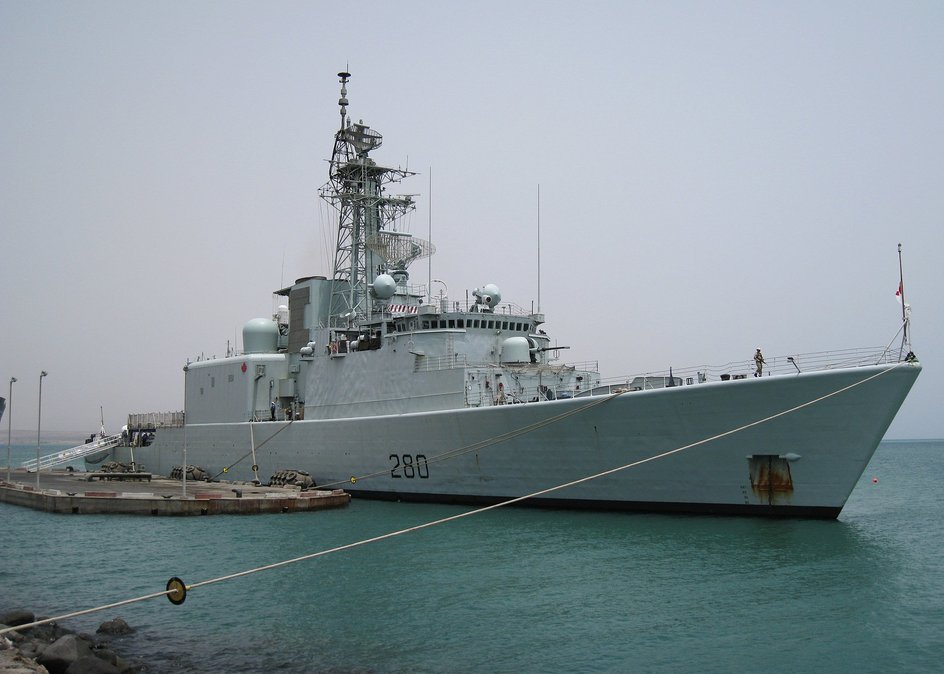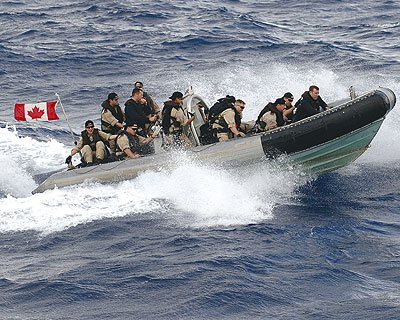HMCS Iroquois
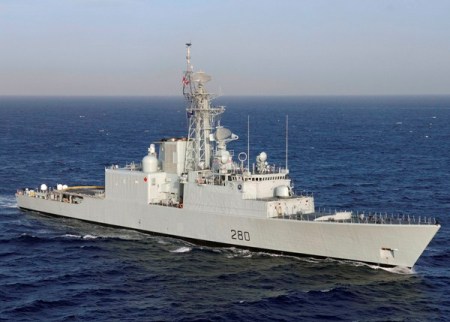
HMCS IROQUOIS, commissioned in 1972, is the first of the modern Tribal-Class Destroyers. She has two sister ships in the Canadian Fleet: HMCS ATHABASKAN based in Halifax, HMCS ALGONQUIN based in Esquimalt, BC. Her third sister ship, the HMCS HURON, was decommissioned in 2003.
The Tribal-Class Destroyers are fitted with state-of-the-art weapons, sensors, command-and-control systems, and propulsion equipment. Together these systems make her capable of carrying out a variety of tasks, aimed at protecting Canadian interests in the oceans adjacent to the coastline, and beyond.
However, combat capability depends on more than modern equipment. It requires dedicated people whose skills depend on constant practice and development. Some 282 men and women of various trades make up IROQUOIS' crew. To these sailors, IROQUOIS is not merely a warship, but a home, an office and a school.
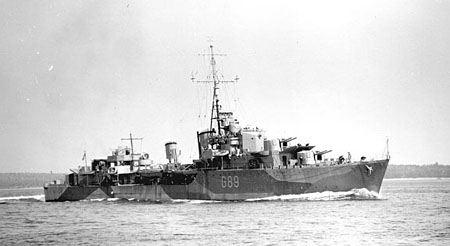
HMCS IROQUOIS was the first "Tribal" destroyer to commission in the Royal Canadian Navy and her arrival marked a new departure in naval warfare for the rapidly expanding Canadian navy.
As far back as the dark days of 1940, when the RCN comprised little more than a scant force of some six pre-war "River" Class destroyers, and even before the first stalwart corvette had made her way to sea, Canadian naval planners were beginning to think in terms of an offensive strategy which would carry Canada's war at sea to the very doorstep of the enemy.
Aggressively armed, the Tribals were designed as hard hitting, swift moving ships of war which would operate with the. Royal Navy's Home Fleet destroyers in the North Atlantic and in the danger studded waters about the British Isles.
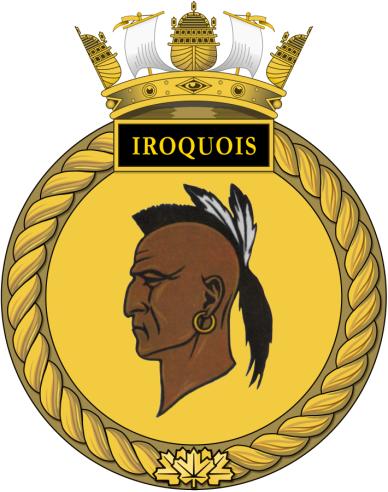
Description:
Or the head of an Iroquois brave couped at the base of the neck properly coloured and wearing two eagle feathers in his hair and a ring or pendant from the ear.
Significance:
In 1942, the ship adopted an unofficial badge in the shape of a shield which bore the head of an Iroquois brave, with his cox-comb hair-style, ring in ear, and war paint. It was taken from a painting by the late C.W. Jeffries and, contrary to usual heraldic practice, faced the viewer's right. The design was retained in the official badge approved after the war, though with the head facing to dexter, the heraldic norm.
Ships Colours: White and Scarlet
Motto: Relentless In Chase
Battle Honours:
The Second World War
* ATLANTIC, 1943
* ARCTIC, 1943-45
* BISCAY, 1943-44
* NORWAY, 1945
United Nations Operation Korea-1950-1953
*
KOREA, 1952-53
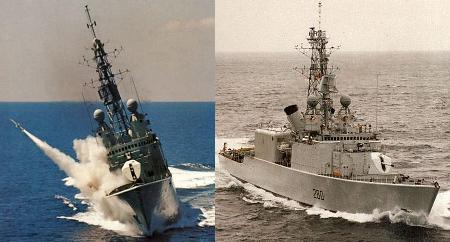
Built at Marine Industries Limited, Sorel Quebec, HMCS Iroquois, the first
Warship of the new Tribal Class was launched on 28 Nov 1970 and commissioned 29 Jul 1972 by the late Mrs. Nora Michener, wife of the late Honorable Roland Michener. Her primary weapons were anti-submarine which included mortars, homing Torpedoes and two CH-124 Sea King helicopters, also armed with torpedoes. The Sea King is an all-weather aircraft which can operate continuously on sustained operation at speeds of up to 150 kts. For defence against air and surface threat, HMCS IROQUOIS was fitted with Canadian Sea Sparrow Point Defence Missile System and 5”54 calibre
gun. Both these systems were radar controlled.
During her 16 ½ years of operation, prior to the Tribal Update and Modernization Program (TRUMP) conversion, HMCS IROQUOIS participated in more than 40 major exercises and 6 Standing Naval Force Atlantic Deployments. Many of the deployment were as Task Group flagship. She played an important role in our coastal defence where she took part in fishery patrols, drug interdictions and search and rescue missions highlighted by a rescue of 20 Korean crew members of the freighter HO MING 5, on Dec 4 1983. As a result of this daring rescue, 12 crew members of the IROQUOIS received the medal of bravery. In all, HMCS IROQUOIS visited in excess of 90 ports, spent 1348 days at sea and steamed more than 385,000 miles (640,000 KM), the equivalent of 16 times around the world.
Today, it is the task of the Navy for a warship at sea to be prepared to meet any threat, be it underwater, on the surface or in the air. In order to meet this requirement IROQUOIS has gone through a 3 year upgrading program. Modernized at MIL Davie at Lauzon, Quebec, IROQUOIS is now a more capable warship, capable of anti-submarine warfare in addition to providing group air defence and capable of Task Group Command and Control. As a result of the TRUMP conversion, HMCS IROQUOIS received its supportive area air defence capability through the installation of the vertically launched medium range surface-to-air standard missile system. Complementing this are the Oto Melara 76mm super rapid gun mount for surface and air self defence and the Phalanx 20mm Close-in Weapons System (CWIS) for anti-missile defence.
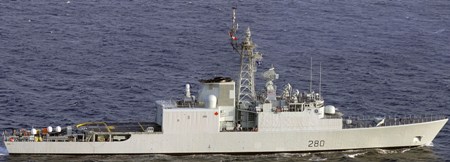
HMCS IROQUOIS maintained her anti-submarine capability utilizing sonar’s, torpedoes and two CH 124 Sea King helicopters. IROQUOIS’ twin helicopters are an extension of its fighting capabilities, carrying their own dipping sonar and torpedoes. They present a formidable threat to high-speed submarines of today. In order to combat any threat she may meet, this warship has been designed to operate under the most adverse conditions. She is insulated and air conditioned for the fighting efficiency and comfort of the crew. The ship can also be sealed against nuclear, biological or chemical attack, with the provision for re-circulation of air within the ship through air conditioning plants.
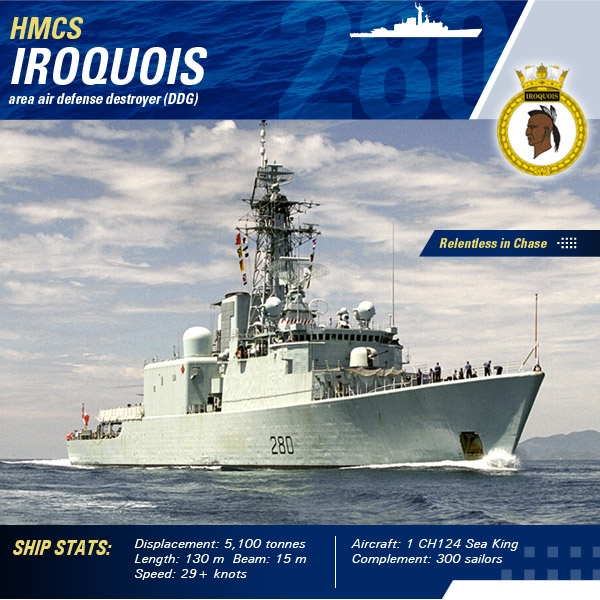
Most functions of the ship, including the fully modernized navigation, culinary, air conditioning, operations and communications equipment and new integrated command and control computers depend upon electrical power. The electrical system needed to drive these and other complex electronics and more extensive than ever before. HMCS IROQUOIS’ generators can produce up to 3250 kilowatts, enough power to maintain a community of 32,000 people.
The electronic and electrical systems in HMCS IROQUOIS are among the most modern in the world today. A computer-driven command and control system gathers data from our ships sensors as well as from accompanying ships, aircraft and satellites and automatically displays this information in the operations room. Internally, this “electronic brain” carries out the orderly processing and dissemination of data and co-ordinates the correct reaction of the ships sensors and weapons.
VITAL STATISTICS:
Displacement (tons) - 5150
Dimensions, meters - 129.9 x 15.7 x 5 keel / 6.9 at propellors
Propulsion - 2 Pratt & Whitney FT4A2 gas turbines, 50 000 shaft horsepower (Main Engines) and 2 GM Allison 570KF gas turbines, 12 800 shaft horsepower (Cruise Engines) which propel 2 shafts with 5 bladed variable reversible pitch propellers.
Speed - 29+ knots, Range - 4500 miles at 20 kts
ARMAMENT:
1. Missiles - 1 Martin Marietta MK 41 Vertical Launch System containing 29 General Dynamics surface-to-air Standard SM2 Block IIIA missiles, command/inertial guidance.
2. Guns: 1 x OTO Melara 76mm (3 inch) / super rapid gun mount, 1 x General Electric/General Dynamics 20mm / 6 barreled Vulcan Phalanx gatling gun, up to 3500 rounds per-minute.
4. Torpedoes - 6 x 324mm MK 32 (2 triple) tubes, firing Honeywell MK46 anti-submarine active/passive homing torpedoes.
5. Aircraft - 2 CH124 Sea Kings
